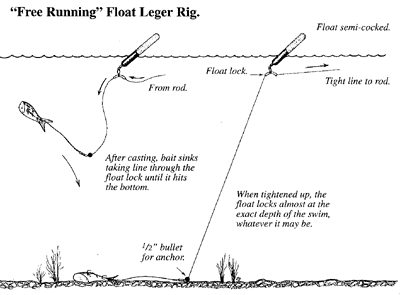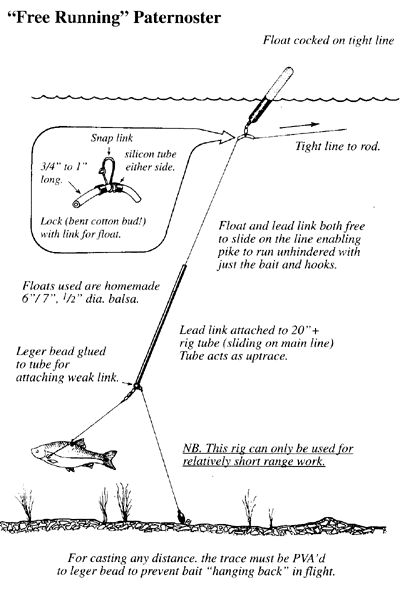 |  |  |
| HOME | CONTENTS | JOIN HERE | |||||
| ABOUT
PAC | |||||||
| When adopting a mobile approach with float
legered baits, continually altering the stop knot so that the float is set at
the correct depth can be time consuming. Mark Houghton's float lock removes the
need for a stop knot and continually plumbing the depth. I don't know if the following has been written about before in the magazine but in this article I would like to describe a method I have developed over the last year for float legering deadbaits without the use of a stop knot. When adopting a mobile approach when piking it can be a chore re-setting stop knots when float legering, especially if one is leapfrogging the rods to cover more water. On my local waters, which are very weedy in the autumn, legering often results in dropped runs, due to the fish running at angles through the weed upon taking the bait. So the use of a surface float is essential to keep the line near the surface. However, as it has been stressed before, a float must not be set too far over depth for efficient registration of takes and on waters with variable depths, re-setting the stop knot every swim can be a real pain. To this end I looked for a way of doing away with the stop knot altogether.  Recently much has been written
on locking floats and float locks for bait trolling and I began looking at the
possibilities of their use from the bank when static fishing. Subsequent experiments
showed that as long as no real distance is being cast, the method worked admirably
so long as a few rules were followed: Recently much has been written
on locking floats and float locks for bait trolling and I began looking at the
possibilities of their use from the bank when static fishing. Subsequent experiments
showed that as long as no real distance is being cast, the method worked admirably
so long as a few rules were followed:1. The float must be buoyant enough to stay on the surface as the line is pulled through the float by the sinking of the bait/lead. 2. A reasonable amount of weight must be used to pull line through the lock. (I use 1/2" non toxic bullets.) 3. The method is restricted to a casting range of 50 yards or so. If cast too hard the float slides right up the line - too far over depth in most cases. In use, after casting, the bait is allowed to sink 'through' the float and immediately it reaches the bottom, the float (bottom end type) is semi-cocked and the line clipped up above the reel. Provided the line is tightened up straight away after the bait hits the bottom, the float will be fishing about 1 1/2 feet over depth at the most. The result is an extremely sensitive set up.  Upon
a take, the float will either slowly go down or fall flat as in the normal float
leger method but if the fish goes on a fast run after taking, the line will, to
a certain extent, run through the float helping to keep the line up off the bottom
away from weed or snags. When playing the fish and retrieving line, the float
will reach the tip ring but will slide back down the line in the same way as when
trolling using locking type floats, allowing the fish to be landed. Upon
a take, the float will either slowly go down or fall flat as in the normal float
leger method but if the fish goes on a fast run after taking, the line will, to
a certain extent, run through the float helping to keep the line up off the bottom
away from weed or snags. When playing the fish and retrieving line, the float
will reach the tip ring but will slide back down the line in the same way as when
trolling using locking type floats, allowing the fish to be landed.The float lock can also be used for paternostering with a surface float. Couple this with a running paternoster boom and the rig becomes totally free running. This article first appeared in Pikelines 72 (May 1996) - on this website 18/1/04 |
| HOME | CONTENTS | JOIN HERE | |||||
| ABOUT
PAC | |||||||